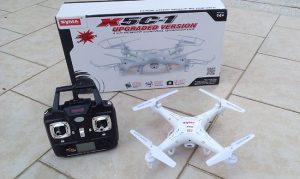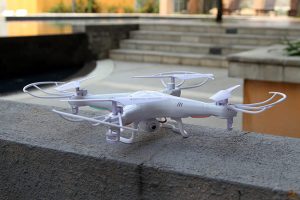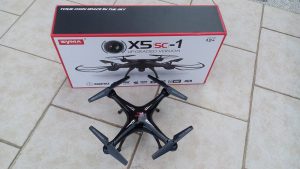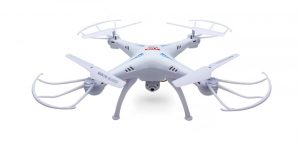The commercial promise of drones has been limited by their short battery lives and propensity for flying off. Now some companies believe they have a solution: tie the drones to the ground.
So-called tethered drones use ultrastrong-but-lightweight cables connected to the ground to provide power, a data link and a physical restraint. That gives them distinct advantages over their free-flying cousins, including hours-long flight times, fast data transmission and an assurance that they won’t fly into an airliner.
Those capabilities have put tethered drones at the center of CNN’s plans to use drones for news coverage. The military is embracing the devices as surveillance tools. And industries including construction, agriculture, mining and public safety are considering tethered drones as a powerful and practical way to persistently gather data on their operations.
Tethered-drone makers, such as Drone Aviation Holding of Jacksonville, Fla., contend their devices can stay in the air longer and transmit data faster than free-flying drones. (Photo by Jensen Hande)
Tethered-drone makers, such as Drone Aviation Holding of Jacksonville, Fla., contend their devices can stay in the air longer and transmit data faster than free-flying drones. (Photo by Jensen Hande)
UPS AND DOWNS
Tethered unmanned aircraft have safety advantages over traditional drones, including the assurance that they won’t fly off into a manned aircraft, but there are drawbacks too.
The Pros:
- Hours-long flight times
- Fast data transmission
- Drone can’t fly off
- Known potential crash area that can be cordoned off.
The Cons:
- Restricted mobility
- Tether adds complexity and could get tangled
- More infrastructure needed on the ground
“It’s like having a near-Earth satellite,” said Helen Greiner, chief executive of tethered-drone maker CyPhy Works Inc. and co-creator of the Roomba, the robotic vacuum. “Once you have an eye in the sky all the time, there are so many things you can do with it.”
In an age of wireless devices, plugging drones in is an inelegant solution. But battery life has been a huge limitation for drones. Free-flying consumer drones can fly for only about 20 minutes, while tethered devices can theoretically stay aloft for days, unlocking new applications. Tethered drones can generally operate at the same heights as their free-flying counterparts.
“It’s like having a near-Earth satellite,” said Helen Greiner, chief executive of tethered-drone maker CyPhy Works Inc.
Motorola Solutions Inc. is selling CyPhy’s devices to police and fire departments to help monitor crime scenes and fires. Motorola also is equipping the drones with its 4G-network technology to turn them into pop-up cell towers for disaster zones.
CyPhy, based in Danvers, Mass., has sold pocket-size tethered drones to the U.S. Air Force to explore unsafe buildings, and Ms. Greiner said customers in mining, construction and agriculture are awaiting regulatory approval to use CyPhy tethered devices.
Companies “don’t want this little thing that flies around for five minutes. They need something that can sit up there for hours and hours on top of a scene,” said Dan Erdberg, chief operating officer of Drone Aviation Holding Corp., a Jacksonville, Fla., firm that makes tethered devices. In addition to CNN, Mr. Erdberg said the sports channel ESPN and professional football teams are in talks to use Drone Aviation’s tethered devices.
The Watt from Drone Aviation can fly as high as 300 feet, weighs 22 lbs. and starts at $75,000. (Photo by Jansen Hande)
The Watt from Drone Aviation can fly as high as 300 feet, weighs 22 lbs. and starts at $75,000. (Photo by Jansen Hande)
Jim Williams, the former top drone official at the Federal Aviation Administration, said tethers can solve the two main risks to traditional wireless drones: loss of power and loss of connection to the operator. But tethered devices also introduce a new risk: a cable hanging hundreds of feet in the air. “You’ve replaced some risks with a new one,” he said. “Is it an overall positive? It depends on the design of the aircraft.”
Companies “don’t want this little thing that flies around for five minutes. They need something that can sit up there for hours and hours on top of a scene,” said Dan Erdberg, chief operating officer of Drone Aviation Holding Corp.
Tethered-drone makers argue their devices are safer than traditional unmanned aircraft because they can’t fly off and, if they crash, the tether keeps the devices within defined areas, which can be cordoned off. They say the tethers also don’t get tangled because the aircraft generally hover in a fixed spot and use an automatic winch to remove slack from the cable. Their stationary nature also means the FAA can notify area pilots about the devices’ positions and altitudes. If the tether breaks, an onboard battery allows the drone to land immediately.
CNN, a unit of Time Warner Inc., has asked the FAA to allow it to use Drone Aviation and CyPhy drones to film the news, arguing in its application that tethered drones are safer than traditional unmanned aircraft. “We felt that the FAA would smile on us,” Greg Agvent, CNN’s senior director of news operations, said at a conference in April. “A tethered drone…could be a potentially safer way to integrate into the national airspace.”
That argument hasn’t yet passed muster with the FAA. The agency says it doesn’t consider tethered drones any different than 50-pound, free-flying unmanned aircraft, meaning they must submit to the same strict standards. Mr. Williams said that because tethered drones can be controlled, unlike tethered balloons or kites, they’re considered aircraft.
The FAA requires its prior approval to fly drones in many cases and restricts flights in cities and near people—where most news happens. In March, when CNN used drones to film a Selma, Ala., bridge 50 years after a civil-rights march there—its first official U.S. drone shoot—the FAA wouldn’t let the device pass above when a car was on the bridge.
CNN, a unit of Time Warner Inc., has asked the FAA to allow it to use Drone Aviation and CyPhy drones to film the news, arguing in its application that tethered drones are safer than traditional unmanned aircraft. “We felt that the FAA would smile on us,” Greg Agvent, CNN’s senior director of news operations, said at a conference in April. “A tethered drone…could be a potentially safer way to integrate into the national airspace.”
That argument hasn’t yet passed muster with the FAA. The agency says it doesn’t consider tethered drones any different than 50-pound, free-flying unmanned aircraft, meaning they must submit to the same strict standards. Mr. Williams said that because tethered drones can be controlled, unlike tethered balloons or kites, they’re considered aircraft.
The FAA requires its prior approval to fly drones in many cases and restricts flights in cities and near people—where most news happens. In March, when CNN used drones to film a Selma, Ala., bridge 50 years after a civil-rights march there—its first official U.S. drone shoot—the FAA wouldn’t let the device pass above when a car was on the bridge.
There is hope for the news channel’s drone plans. As part of a test program, the FAA plans to let CNN use drones, including tethered ones, in urban areas. CNN believes tethered drones could help it cover certain large events, like protests, election-night parties and the next presidential inauguration. “Have you ever been to an inauguration? There are giant camera stands and press boxes,” said David Vigilante, CNN’s senior vice president of legal. “What if you could just pop up a bunch of cameras on a string?”
The idea of tying aircraft to the ground isn’t new. U.S. authorities have used tethered blimps for radar along U.S. borders since the 1980s. This year, the Army launched the first of two 220-foot-long tethered airships, or aerostats, that will float up to 10,000 feet over Maryland.
The aerostats, made by Raytheon Co., can stay aloft for 30 days and track cruise missiles as far as 340 miles away. The tethers power their radar and carry data to the ground.
Indeed, aerostats are already more common than drones for aerial surveillance. Drone Aviation sells a tethered helium balloon equipped with cameras that it calls a “blimp in a box.” The Nashville Police Department has used one since 2011 to watch over large events, like country-music festivals, looking for suspicious behavior. “It works great,” said Nashville Police Sgt. Paul Harbin. “We’ve caught thieves…and drug activity.”
“Before there were drones, there were aerostats. And that’s what still pays the bills,” said Mr. Erdberg of Drone Aviation. “But obviously drones are the future. We’re just waiting for the FAA to open the gates.”



